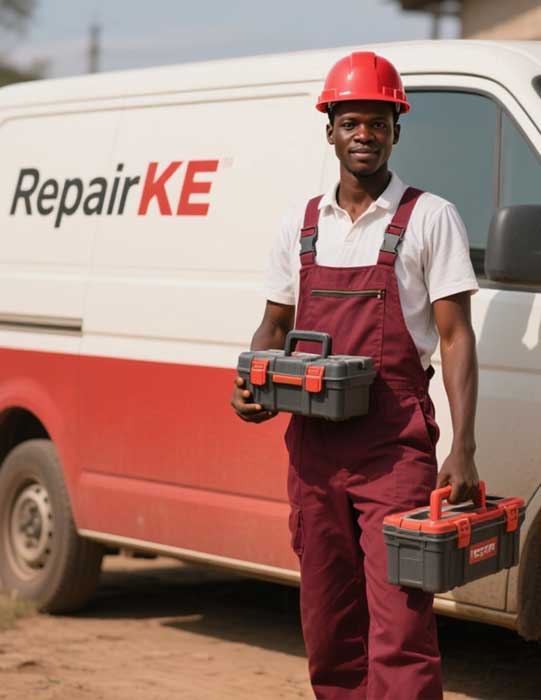
Washing Machine Pressure Switch Issues - Reasons and How We Fix It
The pressure switch in a washing machine is a critical component that regulates water levels during wash and rinse cycles, ensuring optimal performance. When this switch malfunctions, it can disrupt the machine’s operation, leading to issues like overfilling, underfilling, or failure to advance through cycles. Repair.co.ke, a trusted appliance repair service in Kenya, explains the common causes of pressure switch problems and outlines their expert approach to resolving them.
"A faulty pressure switch can turn a routine wash into a frustrating ordeal, but timely repairs restore efficiency." – Repair.co.ke Technician
Understanding the Pressure Switch
The pressure switch, also known as a water level switch, monitors the air pressure in a tube connected to the washing machine’s tub. As water fills the tub, it compresses air in the tube, signaling the switch to stop water inflow at the desired level. A malfunctioning switch disrupts this process, causing operational errors. Repair.co.ke encounters pressure switch issues across various washing machine brands and models, addressing them with precision.
"The pressure switch is like the brain of the water level system, ensuring your machine doesn’t overflow." – Appliance Engineer
Common Reasons for Pressure Switch Issues
Several factors can cause pressure switch malfunctions, ranging from mechanical failures to environmental influences. Below are the primary reasons identified by Repair.co.ke:
Blockages in the Pressure Tube
Debris, detergent residue, or lint can clog the pressure tube, preventing accurate air pressure readings. This leads to incorrect water level detection, causing the machine to overfill or underfill.
Faulty or Worn-Out Switch
Over time, the pressure switch’s internal components, such as the diaphragm or electrical contacts, may wear out due to frequent use. This can result in failure to signal the control board, halting cycle progression.
Electrical Connection Issues
Loose, corroded, or damaged wiring between the pressure switch and the control board can disrupt communication, leading to erratic behavior like continuous filling or premature cycle stops.
Water Damage or Corrosion
Exposure to moisture, common in humid environments, can corrode the switch’s components, impairing its functionality. Leaks within the machine may exacerbate this issue.
Control Board Malfunctions
In some cases, the pressure switch may appear faulty when the real issue lies with the washing machine’s control board, which misinterprets signals from the switch.
"Regular maintenance can prevent pressure switch issues by keeping tubes clear and connections secure." – Repair.co.ke Service Manager
How Repair.co.ke Diagnoses the Problem
Repair.co.ke employs a systematic approach to diagnose pressure switch issues, ensuring accurate identification of the root cause. The process includes:
- Visual Inspection: Technicians check the pressure tube and switch for visible blockages, corrosion, or damage.
- Functional Testing: Using diagnostic tools, they test the switch’s response to air pressure changes, verifying if it activates and deactivates correctly.
- Electrical Checks: Multimeters are used to inspect wiring and connections for continuity and proper voltage.
- Control Board Evaluation: If the switch tests normal, technicians examine the control board for faults that may mimic pressure switch issues.
This thorough diagnosis ensures that repairs target the precise problem, avoiding unnecessary part replacements.
"Accurate diagnosis saves time and money by addressing the true cause of the issue." – Appliance Repair Expert
Repair Solutions by Repair.co.ke
Once the issue is identified, Repair.co.ke implements targeted solutions to restore the washing machine’s functionality. Common fixes include:
Clearing Blockages
Technicians clean or replace clogged pressure tubes, ensuring unobstructed airflow. This simple fix often resolves water level issues without replacing the switch.
Replacing the Pressure Switch
If the switch is faulty, Repair.co.ke sources high-quality, compatible replacements, installing them with precision to match the machine’s specifications.
Repairing Electrical Connections
Loose or damaged wires are repaired or replaced, and connectors are treated to prevent future corrosion. This restores reliable communication between the switch and control board.
Addressing Water Damage
For moisture-related issues, technicians seal leaks, dry affected components, and apply protective coatings to prevent recurrence. In severe cases, the switch is replaced.
Control Board Repairs
If the control board is at fault, Repair.co.ke repairs or reprograms it, or recommends a replacement if damage is extensive.
Post-repair, technicians test the machine through multiple cycles to confirm proper water level regulation and cycle progression.
"Professional repairs extend the lifespan of your washing machine, saving you from costly replacements." – Repair.co.ke Customer Support
Preventive Maintenance Tips
To minimize pressure switch issues, Repair.co.ke advises regular maintenance, such as cleaning the pressure tube during routine servicing, avoiding overloading the machine, and checking for leaks. Scheduling periodic inspections with professionals can catch potential problems early, ensuring long-term reliability.
Repair.co.ke’s expertise in diagnosing and fixing pressure switch issues makes them a trusted choice for washing machine repairs. Their commitment to quality service ensures your appliance operates efficiently, delivering clean laundry without interruption.
Contact Information
For expert washing machine repairs, contact Repair.co.ke:
- Website: repair.co.ke
- Email: info@repair.co.ke




